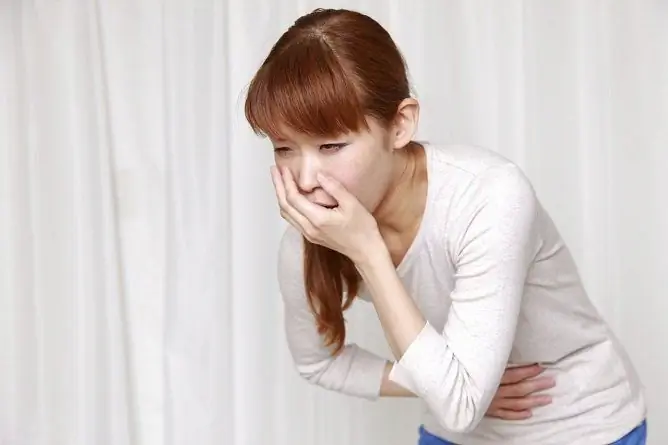- Author Rachel Wainwright [email protected].
- Public 2023-12-15 07:39.
- Last modified 2025-11-02 20:14.
Psychomotor agitation

Acute mental disorders are often accompanied by movement disorders. In a state of excitement, a person makes such movements that have a certain character, most often, destructive. Psychomotor agitation requires increased attention, and a person who has undergone such a pathology needs qualified help from a psychiatrist.
Motor excitement is characteristic of many mental disorders, in other cases it is the only manifestation of the disease. The duration of psychomotor agitation can be different: from several minutes to one week. Much depends on the intensity of movements, clinical manifestations of the underlying disease. However, any state of arousal develops in the same pattern with similar symptoms:
- A sharp beginning, sometimes unexpected for others;
- Violation of the generally accepted model of behavior in society, manifested by completely inappropriate movements;
- Changes in the patient's mood, emotionally colored, up to a state of passion;
- Aggression in the actions of the patient, aimed at defense, attack, or having a suicidal motive.
Persons who develop psychomotor agitation pose a danger both to others and to their own lives. Therefore, the manifestations of acute psychosis are related to conditions requiring immediate medical attention.
Psychomotor agitation, types
Depending on the background on which pathological motor activity develops, the following types of psychomotor agitation are distinguished:
- Depressive;
- Manic;
- Delirious;
- Epileptic;
- Psychopathic;
- Hallucinatory delusional;
- Catatonic;
- Gebephrenic;
- Psychogenic.
Each of the listed conditions has specific features and characteristics.
Psychomotor agitation, types of depression are characterized by a suicidal orientation. Patients try to commit suicide, not paying attention to the reaction of others.
The state of mania is characterized by irrepressible energy. A person takes on a huge number of cases, but he cannot finish any of them, since there are a lot of thoughts in his head. However, some of them may be aggressive. Manic psychomotor agitation is accompanied by verbosity and high spirits.
Delirious arousal, characteristic of the manifestation of delirium tremens, is accompanied by fear and is aimed at protection. At the same time, the surrounding people may seem to be "accomplices" of the aggressors, and the patient may turn out to be dangerous for loved ones.
Clouded consciousness in epilepsy is the most dangerous mental health condition. The patient's consciousness is completely absent, and the actions are extremely aggressive. When the twilight psychomotor agitation stops, the patient does not remember anything. He is horrified by what he has done, feels remorse, but cannot control his own consciousness.
Psychopathic psychomotor agitation arises as a response to a very specific cause and is directed directly at the "offender". At the same time, a completely meaningful action is noted. The movements of the psychopathic personality are demonstrative, theatrical.
Hallucinatory-delusional disorder is characterized by the movements of the "other reality" in which the patient resides. He speaks with only "visible" people to him, can unexpectedly attack anyone standing next to him.
Catatonic psychomotor agitation is characterized by pretentious movements that have no meaning. However, the patient is capable of active resistance when trying to limit his freedom of movement.
Changes in motor activity in hebephrenic form of schizophrenia are of a silly nature. Nevertheless, patients are quite capable of causing injury to themselves and those around them.
Psychogenic psychomotor agitation is caused by a specific cause and is characterized by manifestations of panic fear for one's life.
Psychomotor agitation, treatment
A patient in a state of excitement needs emergency hospitalization in a psychiatric ward. For this purpose, it is necessary to call a specialized ambulance team. When psychomotor agitation develops, only a psychiatrist prescribes treatment.
The primary tactic of healthcare professionals is to immediately immobilize the patient. For this purpose, wide bandage fixation methods are used. In special cases, assistance to doctors is required by law enforcement agencies.
When contact with the patient is possible, the doctor conducts an explanatory conversation. The patient must be told that his condition requires hospitalization and treatment in a specialized hospital.

Medication is also performed on an emergency basis. Large or small tranquilizers are used. Achievements of modern pharmacology make it possible to quickly remove psychomotor agitation and prevent undesirable consequences, both for the patient and for the people around him.
Psychomotor agitation in children
In pediatric practice, such a disorder is quite rare and its appearance is primarily associated with organic damage to the brain. This may be due to birth trauma or acute neuroinfection.
With epilepsy, psychomotor agitation in children, in terms of clinical manifestations, proceeds in exactly the same way as in adults. Twilight clouding of consciousness leads to extremely aggressive actions.
The syndrome of "negativism" in adolescence is often one of the manifestations of the onset of schizophrenia. Psychopathic disorders are hereditary, therefore, dangerous behavior in children is also equated with similar disorders in adults and requires urgent medical attention.
YouTube video related to the article:
The information is generalized and provided for informational purposes only. At the first sign of illness, see your doctor. Self-medication is hazardous to health!






